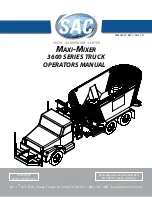
116
Install the batteries into the truck and fix them in the reverse order.
Make sure that the upper clamps are inserted in guides 11. Otherwise, clamp
13 will not be in close contact with stops 9 and 12, and the battery will not be fas-
tened, that can cause its breaking. Avoid deformation of guides 11, when mounting
and fastening the battery.
Avoid pinching and sharp bending of the wires leading to the starter and
«ground» switch as well as harmful contacts of the wires with metal parts of the box,
when installing and fastening the batteries.
After the batteries have been installed into the truck, adjust position of front
wedge stops 9; for this purpose slack off tightening of the bolts 8, fastening stops 9
to cover 6, push stops 9 alongside the extended holes of cover 6 as far as they will
go, and tighten bolts 8. Adjust position of front wedge stops 9 on closed cover 6 of
box 10 upon installing batteries 1 and upper clamps 13 into the box.
Preparation of dry storage batteries for operation.
The procedure of batteries
preparation to make them serviceable is as follows:
- put off the protection hood and cover, remove dust from the batteries and
lubricant from the terminal bolts;
- screw out the filler plugs, remove the sealing gaskets and scour the venti-
lation holes in the plugs;
- cut off the projections available on the polyethylene plugs, and clean the
ventilation ducts;
- pour the electrolyte into the batteries; its density is given in Tabl. 6.
Table 6
Electrolyte density
Climatic zones and regions. Mean
ambient temperature in January, °C
(GOST 16350-70)
Season
Electrolyte density given for 25 °C,
g/cm
3
to be filled
fully charged
battery
Cold zone with climatic re-
gions:
- very cold (from - 50 to
- 30)
- cold (from -30 to -15)
Winter
Summer
All year round
1.28
1.24
1.26
1.30
1.26
1.28
Temperate zone (from -15 to
-8)
Hot zone (from - 15 to +4)
Warm and humid zone (from
0 to +4)
All year round
1.24
1.22
1.20
1.26
1.24
1.22
Note. Permissible deviation of electrolyte density from figures given in the Table is + 0.01
g/cm
3
.
Prepare the electrolyte by diluting the sulphuric acid as per GOST 667-73
Standard (but not the process acid) in distilled water as per GOST 6709-72 Stand-
ard. In so doing use Tabl. 7 for your guidance.
When preparing the electrolyte, pour the acid into the water and not vice
versa.
The temperature of the electrolyte to be poured into the batteries should be
15-30 °C. Upon saturating within 2 hours, bring the electrolyte level up to 10-15 mm
above the safety shield. Right before switching on the battery the temperature of the
electrolyte should not exceed 30
o
C.








































